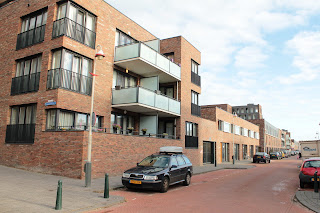
The sea water heating plant is part of the city’s plan to use more sustainable energy and is one of the steps being taken towards making the Hague ‘climate by 2050. Today seawater heating system provides 750 houses in the area of Duindorp with heating and hot water; and it is planned to connect further 300 houses to this system. As Mr Henk Heijkers from the City of the Hague Sustainability Department put it, “my dream is that the whole Scheveningen Harbour area gets fantastic new buildings with the new Duindorp all connected on seawater energy”. Duindorp is a new housing estate area along the North Sea Coast built to replace 1100 old energy inefficient houses that used to be small former fishermen family houses built between 1915 and 1931.

The concept of seawater heating system is innovative but simple: it consists of a seawater central supply unit with a heat exchanger and heat pump unit that uses the nearby sea as a temperature source. The technologies involved are not new, but it is the way they were combines that attracts attention: it is an innovation that allows constructing a very efficient system for making seawater or surface water the source of energy for heating homes as well as heating water – and not only during a warmer season.

The idea of a sustainable heating system was proposed by the housing corporation Vestia – it is now an owner of the seawater heating system. However, it took some time to find the most suitable system: for a few months government authorities, housing corporation, engineering consultancy and utility companies were involved in a process of brainstorming and discussion. Eventually, Mr Paul Stoelinga from Deerns came up with the idea of combining a heat exchanger, a central heat pump and small water pumps in the homes. In summer, the heat exchanger feeds heated water to local grid, drawing enough heat from the seawater to cover residents' need. In winter, the job is taken over by the central screw ammonia heat plant. This allows ensuring that throughout the year residents of the Duindorp houses get indoor comfort and tap water at the right temperature.
While in the Hague, I had a tour around the central unit located near the harbour. This small warehouse-looking building contains both the central heat exchanger and heat pump. Smaller individual heat pumps are installed in each home for further heating.

The overall efficiency of the heat generation process with this system is more than 50% better than with conventional high-efficiency boilers, while the cost to the residents is no higher. Moreover, it results in a 50% reduction in CO2 emissions.
Similar system can be installed pretty much anywhere in the world close to the body of water and it would even be cheaper in case of fresh water, because there’s no need to protect the heat pump, heat exchanger and water pumps against salt corrosion. So why not use it in the UK?
Very impressive!
ReplyDeleteHello! I just wish to give an enormous thumbs up for the nice info you've got right here on this post. I will probably be coming back to your weblog for more soon! Warmtepomp
ReplyDelete